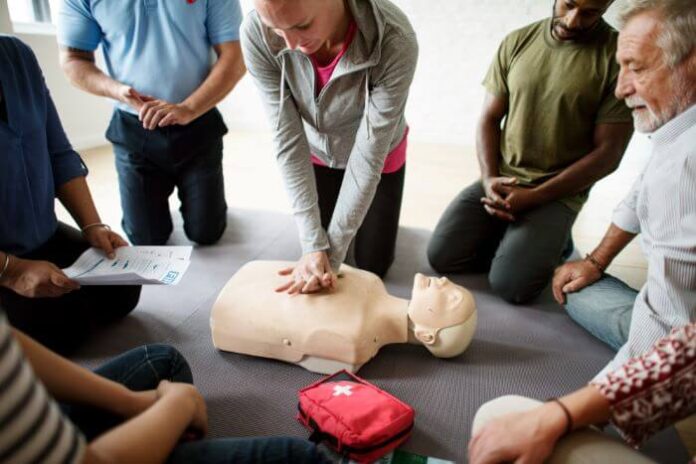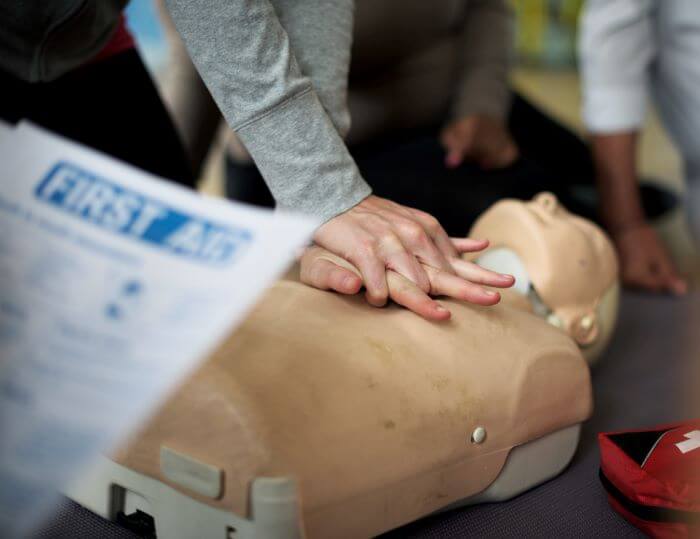Which team role keeps track of interruptions in compressions? Have you ever wondered how teams, especially in high-pressure environments like healthcare, manage to stay coordinated and effective? It’s all about understanding who does what and why.
In scenarios where compressions, such as CPR (cardiopulmonary resuscitation), are crucial, the smooth flow of actions is key. But what happens when there are interruptions? Who keeps an eye on these breaks and ensures that the team remains on track?
That’s exactly what we’re going to unravel in this article. Just keep reading. However, if you are in a hurry to know what the answer is, then let’s help you.
Which team role keeps track of interruptions in compressions? The answer is the time recorder. Yes, the time recorder is the team role in charge of keeping track of interruptions during compressions. Now, let’s take a deeper dive into the question, ‘Which team role keeps track of interruptions in compressions?’
What is a Resuscitation Team and the Importance of CPR
When it comes to saving lives, especially in emergency situations, every second counts. That’s where a resuscitation team comes into play. Think of it as a group of superheroes, but instead of capes, they wear medical scrubs or uniforms.
This team is trained to jump into action when someone’s heart stops or they stop breathing. Their goal is to bring that person back from the brink of death.
CPR, or cardiopulmonary resuscitation, is one of their main tools. It’s a life-saving technique that combines chest compressions (to keep the blood flowing) and rescue breaths (to keep oxygen coming). It’s like manually taking over the job of the heart and lungs, keeping the person alive until more help can arrive.
Why is CPR so important? Well, when the heart stops, the rest of the body, especially the brain, starts to suffer from a lack of oxygen. CPR helps maintain a flow of oxygen-rich blood to the brain, which can prevent serious brain damage and give the person a better chance of full recovery.
Now, you might be thinking, “Can’t just anyone do CPR?” The answer is yes; anyone can learn CPR, and it’s a great skill to have. But in high-stakes situations, like in a hospital or during a major emergency, the resuscitation team’s expertise and coordination become crucial.
They know how to perform CPR effectively, use advanced equipment, and work together seamlessly to give the patient the best possible chance.
What Are Interruptions in Compressions?
Interruptions in compressions during CPR are exactly what they sound like – they’re breaks or pauses in the continuous cycle of chest compressions.
These compressions are crucial because they keep blood flowing through the body when the heart can’t do it on its own. But sometimes, interruptions are necessary. They might happen for various reasons: to check the patient’s response, to allow for medical interventions, or even due to the physical strain on the person performing CPR.
However, it’s vital to minimize these interruptions as much as possible. Why? Because consistent, uninterrupted compressions are key to maintaining blood flow to the brain and other vital organs, which increases the chances of survival and recovery. That is why one person has to be assigned to keep an eye on these interruptions. So, which team role keeps track of interruptions in compressions?
Which Team Role Keeps Track of Interruptions in Compressions?
In a resuscitation team, the role of tracking interruptions in compressions often falls to a designated timekeeper or time recorder. This person has the crucial task of monitoring the CPR process, paying close attention to when and why compressions are paused.
Their job is to minimize these breaks, making sure that they last only as long as absolutely necessary. They also keep an eye on the clock, as the timing of each compression cycle is critical. That means this team member plays a key role in maximizing the effectiveness of CPR, directly impacting the patient’s chances of a successful recovery.
But is that the only role on the team? What other team roles are there on the resuscitation team? Let’s find out.
The 7 Team Roles of the Resuscitation Team
As we said, the timekeeper or time recorder is not the only team role preset on the resuscitation team. There are about six other players on the team, with each member playing a specific, vital role in helping the patient’s recovery. Let’s take a look at these roles and what they do.
-
Team Leader
The team leader is the captain of the ship. They oversee the entire resuscitation process, making critical decisions and guiding the team. Their role involves assessing the situation, assigning tasks, and ensuring communication among team members. They also keep an eye on the overall progress and step in wherever needed.
-
Airway Manager
This role is all about ensuring the patient can breathe. The airway manager is responsible for securing the airway, which might involve using tools like intubation tubes. They make sure that oxygen can get into the lungs, which is a critical part of the CPR process.
-
Compressor
The compressor has a physically demanding role. They perform the chest compressions, a key element of CPR. This role requires strength and endurance, as effective compressions must be consistent and at the correct depth and pace.
-
Defibrillator
The person in this role handles the defibrillator, a device used to give the heart an electric shock (defibrillation). They prepare and operate the defibrillator, and they must be ready to act quickly when the team leader decides it’s time to attempt to shock the heart back into a normal rhythm.
-
IV Medication Provider
This team member is responsible for administering intravenous medications. They prepare and deliver drugs that can be crucial in stabilizing the patient’s condition. They work closely with the team leader to provide the right medications at the right time.
-
Time Recorder
The time recorder, or timekeeper, tracks the duration and frequency of interventions, like compressions and medication administration. They ensure that the CPR is performed with minimal interruptions and that all actions are timed accurately. And that is why they are the answer to the question, ‘Which team role keeps track of interruptions in compressions?’
-
Extra Member
The extra member is the team’s all-rounder. They assist with various tasks as needed, such as preparing equipment, relaying information, or even taking over compressions to give the primary compressor a break. Their flexibility and readiness to fill in wherever needed make them an invaluable part of the team.
When Should Team Roles Switch Compressions?
Switching roles, especially the role of the compressor, is a critical aspect of effective CPR within a resuscitation team. But when is the right time to make the switch? Here are key considerations:
Physical Fatigue: The most common reason for switching the compressor role is physical fatigue. Performing chest compressions is physically demanding, and even the most trained individuals can tire. It’s generally recommended to switch compressors every two minutes to maintain the quality and efficacy of compressions.
Ensuring Consistency: The quality of compressions can decrease as the compressor becomes tired, potentially reducing the effectiveness of CPR. Regular switches ensure that compressions remain consistent in depth and rate.
Procedure Requirements: Sometimes, a switch might be necessary to facilitate a specific procedure or intervention, like defibrillation or advanced airway management. In such cases, the team leader will coordinate the switch to ensure seamless continuation of CPR.
Team Dynamics: In some situations, the team dynamics or the specific needs of the patient may require a switch in roles. This could be due to the specific expertise of team members or changes in the patient’s condition.
Which Team Role Keeps Track of Interruptions in Compressions – Final Note
To bring this to a close, let’s remind you that the team role that keeps track of interruptions in compressions is the timekeeper. But that’s not the only important team role on the resuscitation team. We have been able to show you the others and what they do.
In case you still have questions or concerns concerning this, you can reach out to us using the comment section below. We would definitely be happy to help. But before you go, check the FAQ section below to see if you can get answers to some more questions you might have in your mind concerning CPR and the resuscitation team.
FAQs
What is the most important part of CPR?
The most important part is maintaining uninterrupted, high-quality chest compressions. These compressions ensure that oxygen-rich blood continues to flow to vital organs, particularly the brain and heart, when the heart has stopped beating effectively.
Who provides ventilation in CPR?
In CPR, ventilation is typically provided by the person performing the CPR if they are trained in both chest compressions and rescue breathing.
In a professional setting, such as with a resuscitation team, the role of providing ventilation may be assigned to a specific member, usually the airway manager. This person is responsible for ensuring that the airway is open and for delivering rescue breaths or using ventilation devices as needed.
What is the role of the CPR coach in ACLS?
In Advanced Cardiovascular Life Support (ACLS), the CPR coach plays a crucial role in ensuring the quality of chest compressions and overall adherence to resuscitation guidelines. The coach monitors the rate and depth of compressions, provides feedback to the compressor, and ensures that interruptions are minimized.
Do you give CPR if the person has a pulse?
No, CPR should not be administered to a person who has a detectable pulse. CPR is intended for individuals who are unresponsive and not breathing normally, indicating cardiac arrest. If a pulse is present, it means the heart is still pumping blood, and chest compressions could potentially cause harm.
What is a code blue leader?
A “Code Blue” is a hospital emergency code that indicates a patient is in cardiac arrest or experiencing a life-threatening medical emergency. The “Code Blue leader” is typically a physician or a trained healthcare professional who takes charge during a Code Blue situation.
This leader coordinates the response, assigns roles, makes critical medical decisions, and ensures effective team communication.
Related Articles You Might Like:








